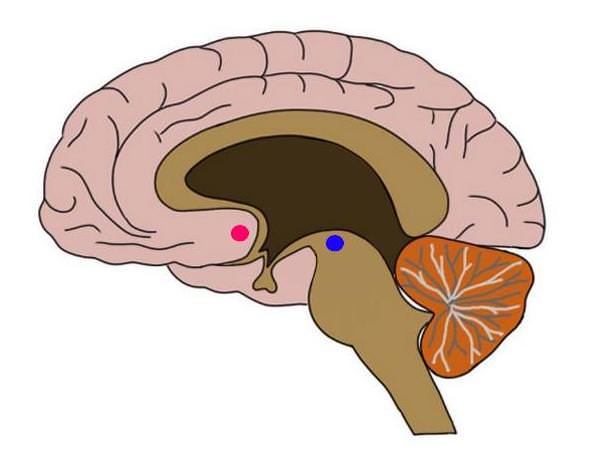Know Your Brain: Reward System
Where is the reward system?

The term reward system refers to a group of structures that are activated by rewarding or reinforcing stimuli (e.g. addictive drugs). When exposed to a rewarding stimulus, the brain responds by increasing release of the neurotransmitter dopamine and thus the structures associated with the reward system are found along the major dopamine pathways in the brain. The mesolimbic dopamine pathway is thought to play a primary role in the reward system. It connects the ventral tegmental area (VTA), one of the principal dopamine-producing areas in the brain, with the nucleus accumbens, an area found in the ventral striatum that is strongly associated with motivation and reward. Another major dopamine pathway, the mesocortical pathway, travels from the VTA to the cerebral cortex and is also considered part of the reward system. So, the reward system is generally considered to be made up of the main dopamine pathways of the brain (especially the mesolimbic pathway) and structures like the VTA and nucleus accumbens, which are connected by these dopamine pathways.
What is the reward system and what does it do?
In the 1950s, James Olds and Peter Milner implanted electrodes in the brains of rats and allowed the animals to press a lever to receive a mild burst of electrical stimulation to their brains. Olds and Milner discovered that there were certain areas of the brain that rats would repeatedly press the lever to receive stimulation to. They found a region known as the septal area, which lies just below the front end of the corpus callosum, to be the most sensitive. One of the rats in their experiment pressed a lever 7500 times in 12 hours to receive electrical stimulation here.
Olds and Milner's experiments were significant because they appeared to verify the existence of brain structures that are devoted to mediating rewarding experiences. For, if the rats were lever-pressing repeatedly to receive stimulation to these areas, it suggested they were enjoying the experience. Subsequent studies attempted to more thoroughly map out these "reward areas," and it was discovered that some of the most sensitive areas are situated along the medial forebrain bundle. The medial forebrain bundle is a large collection of nerve fibers that travels between the VTA and the lateral hypothalamus, making many other connections along the way. Some areas of the medial forebrain bundle were found to be so sensitive that rats would choose receiving stimulation to them over food or sex.
Eventually it was recognized that dopamine neurons are activated during this type of rewarding brain stimulation, and researchers found that they could cause rats to stop lever pressing by administering a dopamine antagonist (a drug that blocks the effects of dopamine). In other words, without the activity of dopamine the rats were less likely to find brain stimulation reinforcing, and so they stopped pressing the lever altogether. Other evidence, such as the discovery that dopamine antagonists seemed to reduce the rewarding qualities of drugs like amphetamines, further supported the importance of dopamine's role in reward.
Based on brain stimulation experiments and the increasingly recognized importance of dopamine in reward, attention began to turn toward major dopamine pathways as playing an important part in mediating rewarding experiences. The medial forebrain bundle connects the dopamine-rich VTA with the nucleus accumbens and is considered part of the mesolimbic dopamine pathway. It eventually became recognized that, when we use an addictive drug or experience something otherwise rewarding, dopamine neurons in the VTA are activated. These neurons project to the nucleus accumbens via the mesolimbic dopamine pathway, and their activation causes dopamine levels in the nucleus accumbens to rise. Furthermore, disrupting this pathway in rodents that had become addicted to pressing a lever for brain stimulation or a drug reward caused them to stop lever-pressing, suggesting these areas are crucially important to the occurrence of addictive behavior.
As the mesolimbic dopamine pathway is activated whenever we use an addictive drug, it has come to be considered the primary pathway of the reward system. However, dopaminergic projections from the VTA travel to the frontal cortex as well; they comprise the mesocortical dopamine pathway. These fibers are also thought to be involved in reward and motivation, although their contribution to rewarding experiences is less clear than that of the mesolimbic pathway.
It's important to note that since the earliest research on the reward system our perspective on dopamine's role in reward has changed slightly. At one time dopamine was considered to be the neurotransmitter responsible for causing the experience of pleasure, but it is now thought to be involved with aspects of reward other than the direct experience of enjoyment. While the details are still being worked out, some have suggested dopamine is involved in encoding memories about a reward (e.g. how to get it, where it was obtained) and attributing importance to environmental stimuli that are associated with the reward.
While the reward system is implicated in pleasurable and potentially addictive behaviors, the substrates of pleasure are not confined to the structures mentioned above and dopamine is not the only neurotransmitter involved. The reward system refers to a group of structures that seem to be frequently involved in mediating rewarding experiences, but the actual network dedicated to creating the feelings we associate with these experiences is likely more complex.
References (in addition to linked text above):
Wise RA (1998). Drug-activation of brain reward pathways. Drug and alcohol dependence, 51(1-2): 13-22.
Learn more:
Watch this 2-Minute Neuroscience video to learn more about the ventral tegmental area and this 2-Minute Neuroscience video to learn more about the nucleus accumbens.
Related articles:


